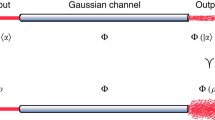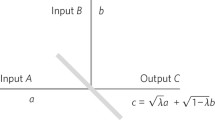Abstract
The set of all channels with a fixed input and output is convex. We first give a convenient formulation of the necessary and sufficient condition for a channel to be an extreme point of this set in terms of the complementary channel, a notion of great importance in quantum information theory. This formulation is based on the general approach to extremality of completely positive maps in an operator algebra in the spirit of Arveson. We then use this formulation to prove our main result: under certain nondegeneracy conditions, environmental purity is necessary and sufficient for the extremality of a bosonic linear (quasifree) channel. It hence follows that a Gaussian channel between finite-mode bosonic systems is extreme if and only if it has minimum noise.
Similar content being viewed by others
References
C. Weedbrook, S. Pirandola, R. Garcia-Patrón, N. J. Cerf, T. C. Ralph, J. H. Shapiro, and S. Lloyd, Rev. Modern Phys., 84, 621–669 (2012); arXiv:1110.3234v1 [quant-ph] (2011).
A. S. Holevo, Quantum Systems, Channels, Information [in Russian], MTsNMO, Moscow (2010).
I. Devetak and P. W. Shor, “The capacity of a quantum channel for simultaneous transmission of classical and quantum information,” arXiv:quant-ph/0311131v3 (2003).
A. S. Holevo, Theory Probab. Appl., 51, 92–100 (2007).
C. King, K. Matsumoto, M. Natanson, and M. B. Ruskai, Markov Process. Related Fields, 13, 391–423 (2007).
W. B. Arveson, Acta Math., 123, 141–224 (1969).
J. S. Ivan, K. Sabapathy, and R. Simon, Phys. Rev. A, 84, 042311 (2011); arXiv:1012.4266v1 [quant-ph] (2010).
M.-D. Choi, Linear Algebra Appl., 10, 285–290 (1975).
S.-K. Tsui, Proc. Amer. Math. Soc., 124, 437–445 (1996).
A. S. Holevo, Probabilistic and Statistical Aspects of Quantum Theory [in Russian], IKI, Moscow (2004).
B. Demoen, P. Vanheuverzwijn, and A. Verbeure, Rep. Math. Phys., 15, 27–39 (1979).
F. Caruso, V. Giovannetti, and A. S. Holevo, New J. Phys., 8, 310 (2006).
R. Simon, M. Selvadoray, and G. S. Agarwal, “Gaussian states for finite number of bosonic degrees of freedom,” Unpublished draft (1998).
A. S. Holevo, Problems Inform. Transmission, 8, No. 1, 47–54 (1972).
A. S. Holevo and R. F. Werner, Phys. Rev. A, 63, 032312 (2001).
G. Lindblad, J. Phys. A, 33, 5059–5076 (2000).
Author information
Authors and Affiliations
Corresponding author
Additional information
__________
Translated from Teoreticheskaya i Matematicheskaya Fizika, Vol. 174, No. 2, pp. 331–341, February, 2013.
Rights and permissions
About this article
Cite this article
Holevo, A.S. Extreme bosonic linear channels. Theor Math Phys 174, 288–297 (2013). https://doi.org/10.1007/s11232-013-0026-0
Received:
Published:
Issue Date:
DOI: https://doi.org/10.1007/s11232-013-0026-0




